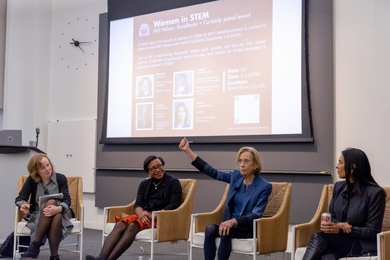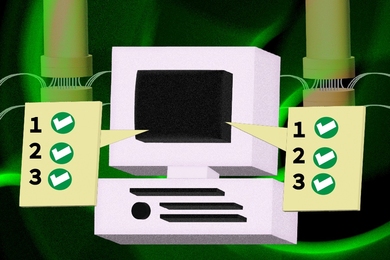On Saturday, 612 students were offered early-action undergraduate admission to MIT’s Class of 2018. The 6,820 students who applied to MIT during the early-action period represent a 4 percent increase from the previous year.
MIT’s early-action program is nonrestrictive and nonbinding; the Institute is conservative in the number of students it admits early.
“That we have so many highly qualified applicants is remarkable, and it makes the job of selecting among them quite difficult,” says MIT Dean of Admissions Stu Schmill. “Those we did admit truly are exceptional.”
Those offered admission to the Class of 2018 are united by their exemplary academic records, exceptional character, and strong match with MIT's mission to make the world a better place. More than one-third have won national or international academic distinctions.
Admitted students come from 49 states and from diverse backgrounds: More than one-quarter identify as members of underrepresented minority groups, and 13 percent will be the first generation in their family to attend college.
“We've spent the last two months getting to know these amazing young people through their applications, which is always so exciting for us. We can't wait to meet them in person and see what they do next,” says Mikey Yang, associate director of admissions and director of the selection process.
This year, MIT Admissions introduced a new maker portfolio supplement as an optional part of the application. In addition to the music and art supplements, which are also optional, the application now provides a structured way for students to submit information on hands-on projects, such as coding a new computer program, rebuilding a car, or designing an entire costume for a play or performance.
“We love it when students pursue their passions outside of class, and making is a fantastic example of that,” says Dawn Wendell, assistant director of admissions.
The maker portfolio is a description of a project completed outside of school, internships, work, or extracurricular activities. The purpose is to see how students learn, create, and problem-solve in an unstructured environment. In addition to answering questions about the project, students may upload up to four images or a one- to three-minute video.
Another change in this year’s early-action admissions process was a switch from traditional portfolio documents to a web-based platform for multimedia portfolios. Advanced musicians interested in continuing their music at MIT can submit a supplement for review by music faculty. Additionally, students interested in continuing their architecture or art activities at MIT can submit a portfolio of up to 10 images for evaluation by MIT faculty and staff in art.
“Our new portfolio system has simplified the process for faculty and staff to review portfolios, and made it easier for admissions officers to view or listen to them,” says Emily Sheldon, assistant director of admissions. “I love being able to listen to an applicant’s music or look at their artwork to appreciate their unique voices and perspectives.”
Admissions decisions were released online on Saturday, Dec. 14. Students were able to share their elation, or their disappointment, and get their questions answered by admission staff and current student bloggers by posting in the Admissions Office’s open blogs for admitted, deferred, and denied students.
MIT’s early-action program is nonrestrictive and nonbinding; the Institute is conservative in the number of students it admits early.
“That we have so many highly qualified applicants is remarkable, and it makes the job of selecting among them quite difficult,” says MIT Dean of Admissions Stu Schmill. “Those we did admit truly are exceptional.”
Those offered admission to the Class of 2018 are united by their exemplary academic records, exceptional character, and strong match with MIT's mission to make the world a better place. More than one-third have won national or international academic distinctions.
Admitted students come from 49 states and from diverse backgrounds: More than one-quarter identify as members of underrepresented minority groups, and 13 percent will be the first generation in their family to attend college.
“We've spent the last two months getting to know these amazing young people through their applications, which is always so exciting for us. We can't wait to meet them in person and see what they do next,” says Mikey Yang, associate director of admissions and director of the selection process.
This year, MIT Admissions introduced a new maker portfolio supplement as an optional part of the application. In addition to the music and art supplements, which are also optional, the application now provides a structured way for students to submit information on hands-on projects, such as coding a new computer program, rebuilding a car, or designing an entire costume for a play or performance.
“We love it when students pursue their passions outside of class, and making is a fantastic example of that,” says Dawn Wendell, assistant director of admissions.
The maker portfolio is a description of a project completed outside of school, internships, work, or extracurricular activities. The purpose is to see how students learn, create, and problem-solve in an unstructured environment. In addition to answering questions about the project, students may upload up to four images or a one- to three-minute video.
Another change in this year’s early-action admissions process was a switch from traditional portfolio documents to a web-based platform for multimedia portfolios. Advanced musicians interested in continuing their music at MIT can submit a supplement for review by music faculty. Additionally, students interested in continuing their architecture or art activities at MIT can submit a portfolio of up to 10 images for evaluation by MIT faculty and staff in art.
“Our new portfolio system has simplified the process for faculty and staff to review portfolios, and made it easier for admissions officers to view or listen to them,” says Emily Sheldon, assistant director of admissions. “I love being able to listen to an applicant’s music or look at their artwork to appreciate their unique voices and perspectives.”
Admissions decisions were released online on Saturday, Dec. 14. Students were able to share their elation, or their disappointment, and get their questions answered by admission staff and current student bloggers by posting in the Admissions Office’s open blogs for admitted, deferred, and denied students.





